Autonomous heating is a complex set of elements, the operation of which largely depends on a correctly drawn up pipeline diagram. It must meet several requirements: transportation of the coolant, ensuring minimum heat losses, reliability of operation and compliance with the operational characteristics of the system. What is the optimal laying of pipes for the heating system: in a private house, in the floor, in the ground?
Rules for laying heating pipes
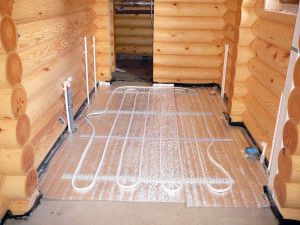
In the process of designing a system, you need to take into account the rules for laying heating pipelines. They describe in detail the characteristics of transport routes, both in-house and for district heating.
The main regulatory document currently is SNiP laying of heating pipelines. It is best to use the current edition, and in particular - SNiP 41-01-2003. In addition to the requirements for the organization of district heating, it provides recommendations for laying pipelines for autonomous heating.
Regardless of whether heating pipes are laid in a wooden house or built of bricks, the following rules must be observed:
- The coolant temperature should not exceed 95 ° С, and the nominal pressure should not exceed 1 MPa;
- It is impossible to lay pipes in unheated attics, cellars and underground if the design temperature in winter is below -40 ° С;
- Compliance with the optimal speed of movement of the coolant, depending on the noise level. The average indicator for autonomous systems is 0.5-0.7 m / s. It directly depends on the diameter of the pipeline, the power of the circulation pump and the heating boiler;
- Hidden laying of heating pipes in skirting boards or in wall grooves is carried out taking into account the properties of building materials. The thermal effect from the surface of the line should not change the appearance or affect safety;
- Pipe material: metal, plastic or metal-plastic. In this case, only steel pipes must be installed at the outlet and inlet of the boiler. Their length must be at least 0.5 m.
These are general recommendations, the observance of which is mandatory for any method of organizing heat transport lines. But it is important for the consumer to know the intricacies of the technology by which heating pipes are laid in the floor or walls.
In a gravitational heating system, the slope of the pipes must be observed. It should be at least 0.3 cm per 1 lm. The same applies to the return line to the boiler.
Internal routing of heating pipes
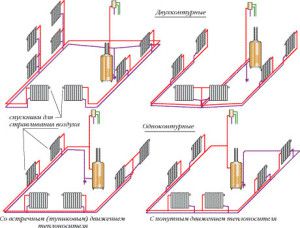
Most often, open installation of pipelines is performed. This is the best and most economical way, but first you should install all the components of the system - radiators, batteries, boiler. Only then can the installation of highways be done. For better sealing of joints, gaskets for radiators should be used. They can be rubber (for low temperature systems), paranitic (high temperature) or plastic.
What are the best ways to lay heating pipes in a one-story building? It depends on the characteristics of the future system.
Underfloor heating installation
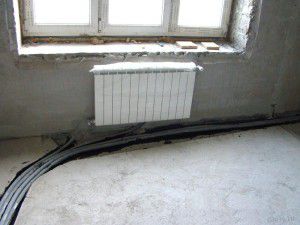
The main rule for laying heating pipelines under the floor covering is the maintainability of the system. This means that, regardless of the material of manufacture of the floor or pipes, it is necessary to provide free access to certain nodes of the line.
These include branching, collector mounting locations, corner elements. For this, inspection hatches should be installed. Their size should ensure the repair and maintenance of systems, especially if heating pipes are laid in a wooden house. What else do you need to consider when installing this type of installation?
- Heat loss... If the installation is carried out in a cement screed, it is recommended to use protective materials with a high heat transfer resistance. These include expanded polyethylene, expanded polystyrene, etc .;
- If heating pipes are laid in a plastic floor, it is taken into account difference in thermal expansion of materials manufacture of the line. For this, compensation loops should be installed;
- If the installation is carried out directly into the insulation, you need take into account its operational parameters... In particular, the maximum possible exposure temperature.
| Material | Maximum exposure temperature, ° С |
| Foamed polyethylene | 80 |
| Expanded polystyrene | 90 |
| Styrofoam | 60 |
| Basalt (mineral) wool | 700 |
Installation of pipe fittings is carried out in the places of turns, branching. On straight sections, the installation interval of fasteners depends on the material of manufacture of the pipes. SNiP for laying heating pipelines does not regulate this. But to ensure the reliability of the system and reduce noise, it is recommended to fasten steel lines on straight sections every 300 mm, and for plastic ones - every 200.
If a diagonal method of laying heating pipelines in a one-story building under the floor is used, furniture must not be installed in the place where the pipeline passes. This will lead not only to its damage, but also to excessive thermal effect on the floor screed.
Heating laying under skirting boards
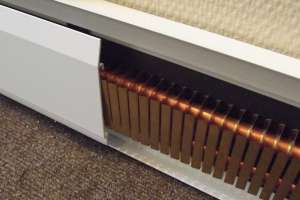
For laying heating pipes in skirting boards, you must first purchase the appropriate consumables. The best option is to buy special skirting boards with installed pipes and heat exchange plates.
Considering the material of manufacture, the cost of such plinth convectors is quite high - from 700 rubles / r.m. Therefore, most often they make the laying of heating batteries in the wall, and then install the plinth.
The features of such an organization of the system are:
- It is not allowed to make strobes in the load-bearing wall. Alternative - installation of pipes under the floor;
- The skirting board material should not change its properties under the influence of temperature;
- Regardless of the method of laying heating pipelines in a one-story building, the minimum distance between pipes (direct and return) should be 15 cm.
After installation, the joints are pressed first, the tightness is checked during the first test run, and only then the decorative plinth is installed.
When laying heating pipes in baseboards, you need to calculate the number of swivel nodes. As far as possible, it is necessary to avoid the installation of unnecessary corners, since because of them the hydrodynamic resistance increases during the movement of the coolant.
Underground heating pipes
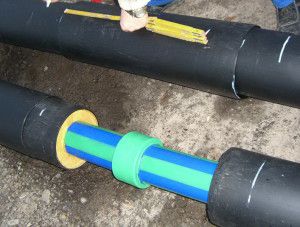
In a private house, it may be necessary to lay heating pipes underground. Such a scheme is used for a stand-alone boiler room or for supplying a heating main to other buildings - a garage, outbuildings, etc.
For the correct laying of heating pipes underground, the following rules must be taken into account:
- The main line can be located above the level of freezing of the soil, but then protection against the formation of ice plugs should be provided. At the same time, heat losses will increase;
- The coolant supply cannot be at the same level or below the return pipe;
- Protection against possible soil pressure. If it is not foreseen, there is a possibility of deformation or destruction of the pipeline.
The correct heating pipe is preselected for laying in the ground. It must without fail have external frost protection. Depending on the soil temperature in winter, this can be passive or active insulation.
To improve the thermal insulation qualities, you can fill the mounting trench with expanded clay on top of the sand layer.
Passive protection of heating pipes
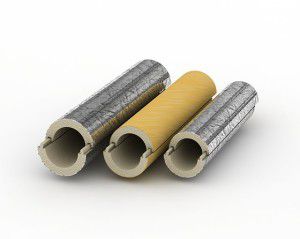
It is a protective cocoon (shell), leveled over the line. It is best to purchase ready-made heating pipes for laying in the ground. A multilayer "cake" is placed on top of the plastic line. It not only protects against the effects of negative temperatures, but also shifts the "dew point". This reduces the likelihood of condensation on the pipeline.
Taking into account the rules for laying pipelines for heating systems, the following types of heat-insulating materials can be distinguished:
- Basalt wool... In addition to good thermal insulation qualities, it is hygroscopic, i.e. moisture from the pipe surface will be removed through the cotton wool;
- Foamed polyethylene... Recommended for use in combination with mineral wool. It forms the primary heat-insulating layer, and the basalt insulation protects the line from the effects of low temperatures;
- Expanded polystyrene shell... The best option for laying heating pipes at a shallow depth. Sealing is ensured with the help of special locks, which, after installation, are insulated with tape.
However, unlike laying heating pipelines in the floor, it is necessary to constantly ensure a high temperature of the coolant. Even the best passive protection with insulation will not be able to provide the formation of ice plugs.
For regions with extremely low temperatures, the special Uponor Ecoflex Thermo Twin pipe can be used for external heating. In addition to reliable thermal insulation, it is equipped with a heating cable.
Heating cable for heating
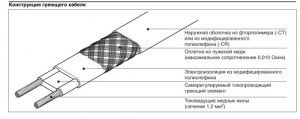
According to SNiP for the external laying of heating pipelines, the possibility of using external heat sources is not provided. But in practice, in autonomous systems with an external pipeline, this is one of the best ways to protect the pipeline from freezing.
The principle of operation of the heating cable is simple - a resistive interaction occurs between the two wires, as a result of which electrical energy is transformed into thermal energy. This scheme can also be used for laying heating pipes in a wooden cottage in technical rooms, where the thermal insulation of the walls is low.
It is best to use self-adjusting models. A polymer filler with a variable electrical resistance is located between the conductors. As the temperature decreases, the electrical resistance decreases, resulting in an increase in the cable temperature. Thus, the surface of the heating pipe installed in the ground is heated.
What else needs to be considered when laying pipes for the heating system: in a private house, in the floor, in the ground? If there is a possibility of exposure to negative temperatures, you can use a special antifreeze instead of water. Its crystallization temperature is below 0 ° C and depends on the concentration. For propylene glycol formulations, the lower limit may be -60 ° C.
The video material describes the pipes that are recommended to be installed for underfloor collector heating:







